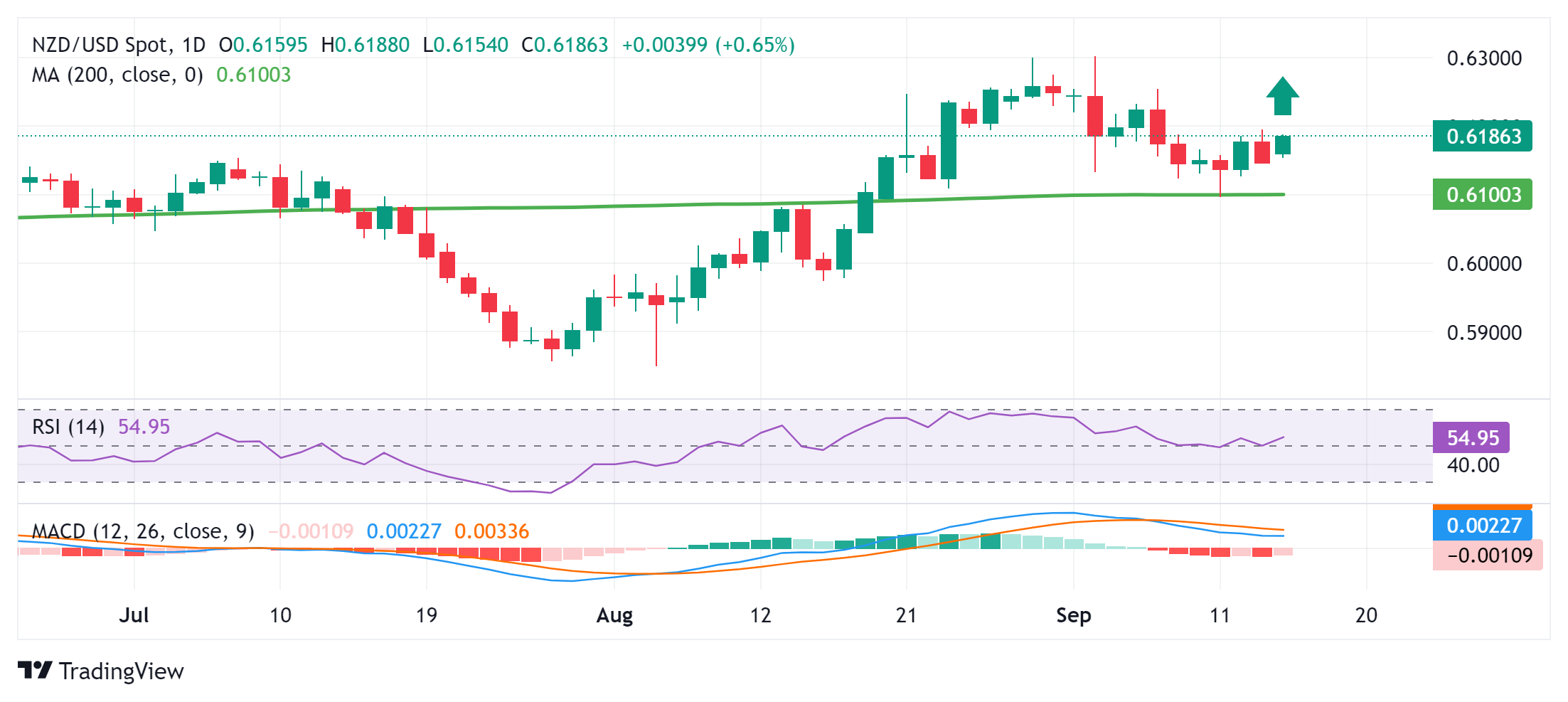- NZD/USD regains positive traction on Monday amid broad-based USD weakness.
- A sustained move beyond the 0.6200 level should pave the way for further gains.
- However, traders could wait on the sidelines ahead of the Fed on Wednesday.
The NZD/USD pair attracts some buying at lower levels on the first day of the new week and reverses a large part of Friday’s pullback from the 0.6200 vicinity, or a one-week high, amid a renewed selling bias around the US Dollar (USD). Spot prices rise to the 0.6180-0.6185 region during the first half of the European session and look set to build on last week’s bounce from the all-important 200-day Simple Moving Average (SMA).
Mounting bets on a 50 basis point interest rate cut by the Federal Reserve (Fed) dragged the US Dollar Index (DXY) back near the year-on-year low and lent support to the NZD/USD pair. Adding to this, a generally positive tone around equity markets seems to be undermining the safe-haven dollar, helping to offset a slew of disappointing Chinese macroeconomic data released over the weekend and benefiting the risk-sensitive Kiwi.
From a technical perspective, oscillators on the daily chart – although they have been recovering from lower levels – are yet to confirm a positive bias. This makes it prudent to wait for some follow-through buying beyond the 0.6200 level before taking a bullish position and ahead of the FOMC decision on Wednesday. The NZD/USD pair could then rise to the 0.6255 zone en route to the 0.6300 level or a multi-month high touched in August.
On the downside, the 0.6155 region now seems to protect the immediate downside ahead of the Asian session low, around the 0.6135 area. This is followed by the 0.6100 level, or the 200-day SMA, which if broken decisively will be seen as a fresh trigger for the bears. The downward trajectory could then extend towards the intermediate support of 0.6045 before the NZD/USD pair eventually drops to the psychological level of 0.6000.
NZD/USD daily chart
New Zealand Dollar FAQs
The New Zealand Dollar (NZD), also known as the Kiwi, is a well-known currency among investors. Its value is largely determined by the health of the New Zealand economy and the policies of the country’s central bank. However, there are some peculiarities that can also cause the NZD to move. Developments in the Chinese economy tend to move the Kiwi because China is New Zealand’s largest trading partner. Bad news for the Chinese economy will likely translate into fewer New Zealand exports to the country, which will affect the economy and therefore its currency. Another factor that moves the NZD is dairy prices, as the dairy industry is New Zealand’s main export. High dairy prices boost export earnings, contributing positively to the economy and therefore the NZD.
The Reserve Bank of New Zealand (RBNZ) aims to achieve and maintain an inflation rate of between 1% and 3% over the medium term, with the aim of keeping it close to the midpoint of 2%. To do this, the bank sets an appropriate level of interest rates. When inflation is too high, the RBNZ raises interest rates to cool the economy, but the move will also push up bond yields, increasing the attractiveness of investors to invest in the country and thus boosting the NZD. Conversely, lower interest rates tend to weaken the NZD. The so-called rate spread, or how rates in New Zealand are or are expected to be compared to those set by the US Federal Reserve, can also play a key role in the movement of the NZD/USD pair.
Macroeconomic data releases in New Zealand are key to assessing the state of the economy and can influence the valuation of the New Zealand Dollar (NZD). A strong economy, based on high economic growth, low unemployment and high confidence is good for the NZD. High economic growth attracts foreign investment and can encourage the Reserve Bank of New Zealand to raise interest rates if this economic strength is accompanied by high inflation. Conversely, if economic data is weak, the NZD is likely to depreciate.
The New Zealand Dollar (NZD) tends to strengthen during periods of risk appetite, or when investors perceive that overall market risks are low and are optimistic about growth. This often translates into a more favourable outlook for commodities and so-called “commodity currencies” such as the kiwi. Conversely, the NZD tends to weaken during times of market turmoil or economic uncertainty, as investors tend to sell riskier assets and flee to more stable havens.
Source: Fx Street
I am Joshua Winder, a senior-level journalist and editor at World Stock Market. I specialize in covering news related to the stock market and economic trends. With more than 8 years of experience in this field, I have become an expert in financial reporting.








